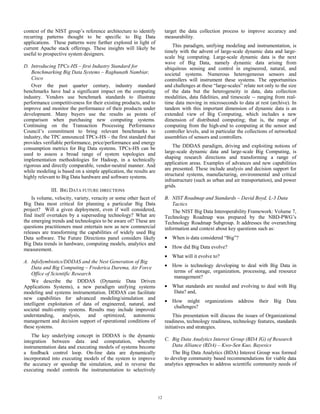This document summarizes discussions from a workshop organized by the National Institute of Standards and Technology's (NIST) Big Data Public Working Group. The workshop included four panels that discussed: 1) the current state of big data technologies; 2) future trends in big data hardware, computing models, analytics and measurement; 3) methods for improving big data sharing and collaboration; and 4) security and privacy concerns with big data. The panels featured presentations on topics such as big data reference architectures, use cases, benchmarks, data consistency issues, and approaches for enabling secure big data applications while preserving privacy.




![Seven SBEs are required by statute to ensure FERPA com-
pliance. Fifty-five bills introduced in 2014 would give SBEs
some authority in regulating student data privacy. Existing
state privacy laws give many SBEs authority over various
things to help secure data privacy, including appointing a chief
privacy officer, adopting and/or implementing state privacy
policies, and providing oversight of vendor contracts. SBEs
have also independently passed rules for their states to protect
data privacy. Unfortunately, like many other policymakers,
many SBE members are unaware of the potential benefits of
Big Data in education. Education data privacy requires
knowledge of privacy law, a basic understanding of Big Data,
and a great deal of time to learn about the ins and outs of
todays education data privacy debate. The National
Association of State Boards of Education (NASBE) is helping
SBEs understand and pass effective policies on these issues
that will protect data privacy while supporting educational
innovation through the use of Big Data. In this panel, Amelia
Vance from NASBE will discuss the role SBEs play in
education data collection, the questions they are asking as they
put together state privacy policies (particularly those dealing
with third party use of data), and what information
policymakers need from technology providers in order to trust
the use of Big Data in education.
We consider the perspectives and recommendations from
multiple organizations and experts, including the Data Quality
Campaign, the Electronic Privacy Information Center, and the
Pioneer Institute, as well as examine the lessons learned thus
far in states from failed attempts in responsible data collection
and privacy security.
ACKNOWLEDGMENT
The authors wish to thank the panelists for their time and
efforts to share their expertise and further the dialog for
clarifying the new discipline of Big Data. The authors also
wish to acknowledge the contributions of the large group of
participants in the NBD-PWG, who have discussed at length
the emerging discipline of Big Data, and have helped form a
collective understanding of this new paradigm.
REFERENCES
[1] N. Grady, W. Chang, eds. “NIST Big Data Interoperability Framework:
Volume 1, Definitions” NIST. unpublished.
[2] N. Grady, W. Chang, eds. “NIST Big Data Interoperability Framework:
Volume 2, Taxonomy” NIST. unpublished.
[3] G. Fox, W. Chang, eds. “NIST Big Data Interoperability Framework:
Volume 3, Use Cases and Requirements” NIST. unpublished.
[4] A. Roy, M. Underwood, W. Chang, eds. “NIST Big Data
Interoperability Framework: Volume 4, Security and Privacy
Requirements” NIST. unpublished.
[5] S. Mishra, W. Chang, eds. “NIST Big Data Interoperability Framework:
Volume 5, Architectures White Paper Survey” NIST. unpublished.
[6] O. Levin, W. Chang, eds. “NIST Big Data Interoperability Framework:
Volume 6, Reference Architecture” NIST. unpublished.
[7] D. Boyd, C. Buffington, W. Chang, eds. “NIST Big Data
Interoperability Framework: Volume 7, Taxonomy” NIST. unpublished.
15](https://image.slidesharecdn.com/qren5mfatyecqiq2x87v-signature-e8e60906c738f9c32f4cb86b7fcf9e14f38f5d868e9d30b8af534f3121f3fd29-poli-170428171757/85/Big-data-Challenges-Practices-and-Technologies-5-320.jpg)